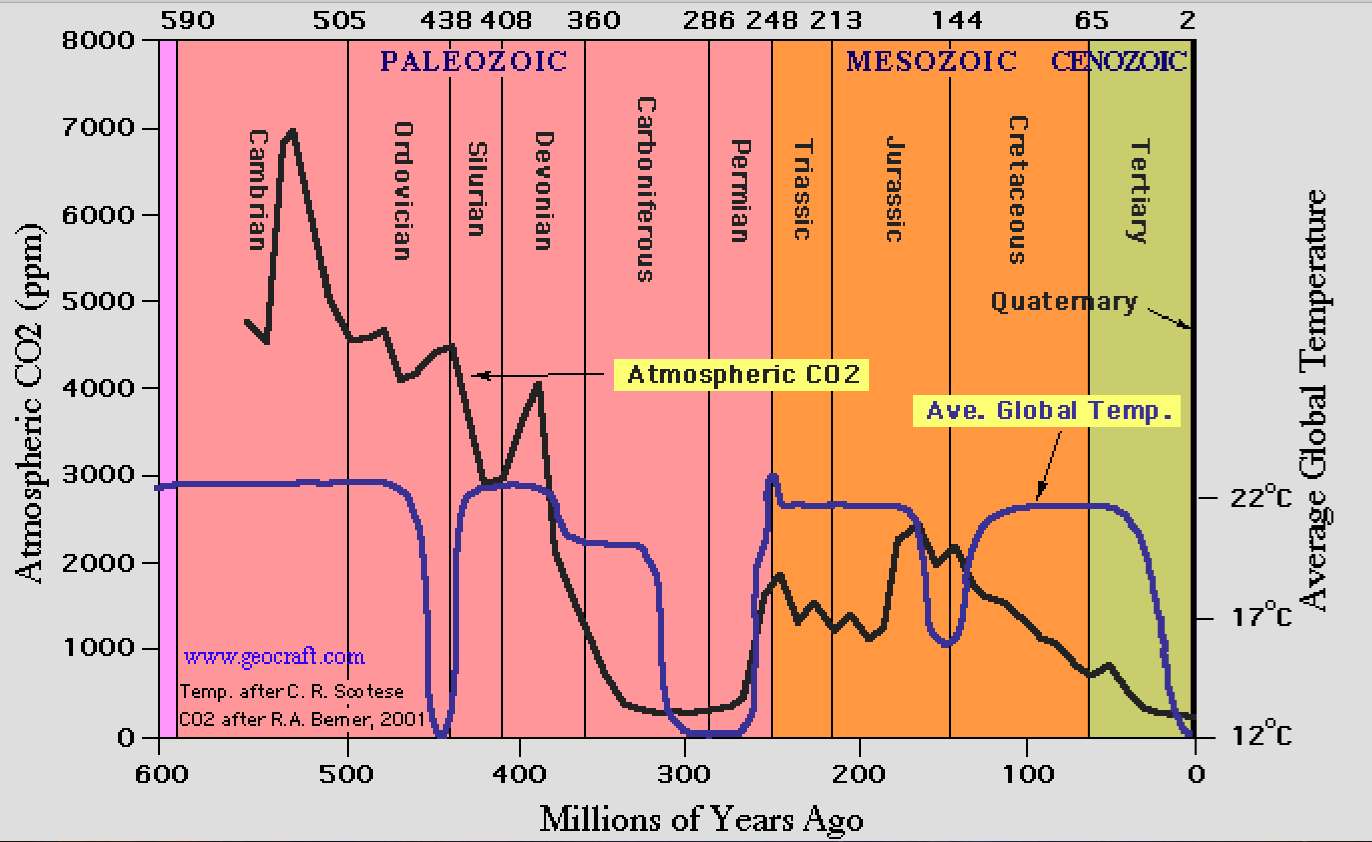CO2 Levels In Air Dangerously Low for Life on Earth
Atmospheric CO2 concentrations and average global temperatures for the past 550 million years on Earth.
Carbon dioxide levels from Brener (2001) and temperature from Scotese (2001) sourced from www.geocraft.com.
See also Boucot et al. (2004)
See bottom of post for complete references.
Image Credit: The Consulting Geologist
For the past two weeks or so, I just have not been able to get away from the subject of global warming. Every time I turn around, I seem to learn yet more reasons why the popular picture of Anthropogenic Global Warming (AGW) is not to be believed. Now I have run across data indicating our current levels of atmospheric CO2 are actually dangerously low for life on Earth.
The Record of the Past
In fact, if you were to plot average global temperatures and atmospheric CO2 concentrations over the past 550 millennia, derivable from glacier ice cores and marine sediments, you would get the plot shown at the top of this post. From this plot you can see that approximately 540 million years ago, carbon dioxide in the air peaked at almost 7,000 parts per million! Given current hysteria over the paltry 400 ppm we presently have, these kinds of enormous CO2 concentrations must have caused tremendous atmospheric heating and been extremely detrimental to life at the time — Right?
Yet average temperatures at the time were only about 22°C (71.6°F), approximately 8°C above our current global average of around 14°C (57.2°F). Rather than being detrimental to life, this peak in atmospheric CO2 coincided with the greatest eruption of life the Earth has ever experienced: the Cambrian Explosion during the Cambrian period of the Paleozoic Era. During this time, almost all of the modern plant and animal phyla we know today arose. We could only hope for and dream of such a “detrimental” environment!
One very important lesson to take away from this graph, is that carbon dioxide concentrations have generally declined from the Cambrian to the present age. They reached almost modern levels in the Carboniferous and Permian periods of the Paleozoic (~375 million to 270 million years ago), only to rise slightly during the Triassic and Jurassic periods of the Mesozoic Era (~250 million to 175 million years ago). Since then, CO2 concentrations have followed almost a straight line downwards. Our current increases in atmospheric carbon dioxide are only a very short-term, unobservable blip on this very long-term record. What has caused the long-term decline in atmospheric CO2 should be fairly obvious. The cause is the sequestration of carbon dioxide by plant life into the fossil fuels of coal, oil, and natural gas, taking the carbon dioxide completely out of the atmospheric and biological systems of Earth. The rise of atmospheric CO2 in the Triassic and Jurassic periods is a mystery to me on which I will not hazard a guess.
Why We Need Higher CO2 Levels!
From this past record we can conclude we have absolutely nothing to fear from increasing CO2 levels and much for which to hope with an increasing abundance of plant life. Yet, one tale you almost certainly have not heard is that we do have a great deal to fear if atmospheric carbon dioxide is allowed to decrease. Biologists have shown plant life begins to suffer greatly once CO2 levels fall below 500 ppm, the situation we suffer today. Consider the effects of increasing CO2 as shown in the plots below, taken from Ehleringer et al. (2005).

NoTricksZone / Ehleringer et al. (2005)
Yet, seeing is believing. Take a gander at the following video showing time-lapse photography of the growth of two cowpea plants. One is in a chamber with ambient CO2 (450 ppm) and one in a chamber with elevated CO2 (1270 ppm).
Should the CO2 levels ever fall below 150 ppm, massive die-offs of plant life could be expected. As the NoTricksZone post by Pierre Gosselin, at which I found the plots above, put it: “Do we really want to live on the brink of extinction?” Better to subsidize the burning of fossil fuels to replenish our atmospheric CO2!
References
Berner, R.A., 2001, “Modeling Atmospheric Oxygen Over Phanerozoic Time”, Geochimica et Cosmochimica Acta, v. 65, pp. 685-694.
Boucot, A. J., Xu, C., and Scotese, C. R., 2004, “Phanerozoic climate zones and paleogeography with consideration of atmospheric CO2 levels”, Paleontologicheskiy Zhurnal, v. 2, pp. 3-11
Ehleringer, James R., Thure E. Cerling, and Dearing M. Denise, editors. A History of Atmospheric CO2 and Its Effects on Plants, Animals, and Ecosystems. New York. Springer Science+Business Media. 2005
Scotese, C. R., 2001, “Paleomap Project”, http://www.scotese.com/climate.htm
Views: 11,328































Great article, Charles. If only this information were widely known.